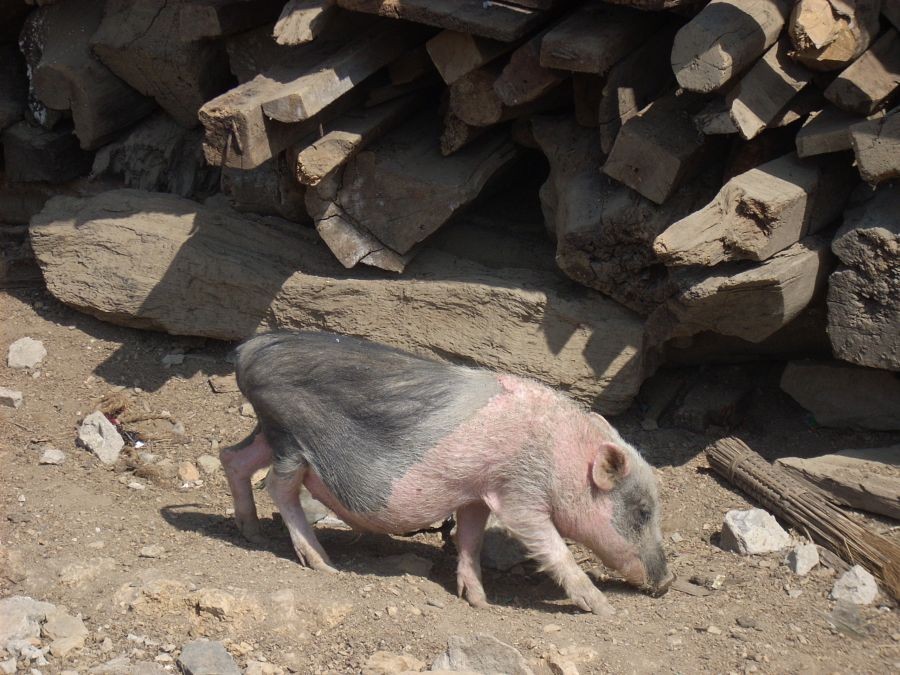An indigenous pig from Nagaland grazes near a house. (Morung file Photo)

Abokali Jimomi
Dimapur | February 28
Dimapur | February 28
Pork is a primary food item in the State of Nagaland. A majority of Nagaland’s over 20 lakh people take pork as part of a traditional diet; the demand is unlikely to decrease yet. Nagaland State’s pork market is dependent on supply from outside as the local production level is insufficient to meet the demand. Several factors are deterring local farmers from producing enough for domestic consumption; one factor is the pricing of supply pork against which local farmers are unable to compete.
A Naga piggery owner, Savino, who has been raising pigs for over 20 years, says, “The cost of feed outside the State must be very less. Otherwise, how would they be able to rear so many pigs?”
At present, the retail price of local pork is not less than Rs.200 a Kg whereas, strangely, ‘Supply Pork’ costs anywhere between Rs.160 to Rs.180 per Kg. Moreover, the more remote an area is from distribution hubs, like Dimapur and Mokokchung, higher the price. This is due to logistical costs involved, which applies to prices of all imported fresh food items.
This shows that people with lower incomes, living in remote areas of Nagaland, with poor transport connectivity and with lesser income opportunities, are doubly disadvantaged. Consumers are relatively aware that Supply Pork is of lower quality and therefore prefer local pork; however, price and availability become dominating influences on their buying decision, especially for those with lower disposable incomes – who comprise the highest percentage of the Naga public.
According to findings of a study conducted on the ‘Supply Chain of Pigs from Outside the State’ by Dr. Simon Ao, bulk of Nagaland’s pork supply comes from Uttar Pradesh: Barielly, Badayu, Bewar (Mainpuri), Bidhuna (Auraya), Farukabad (Fathenagar), Kanpur, Rae Barielly, Amethi, Faizabad, Jaunpur, Allahabad – Mehowa, Naini & Begum Bazaar, Gonda and Balia etc. The supply route starts from NH 24 connecting to NH 39, and pigs transported to Dimapur (Nagaland), Jorahbad (for Megahlaya and Assam) and Mizoram.
According to the 2010-11 Administrative Annual Report of the Department of veterinary and animal husbandry, Government of Nagaland, Nagaland’s total livestock import stood at Rs. 221.67 crores. Of this, a majority might be of pork, given that 207 pigs are slaughtered daily throughout Nagaland (supply pork), as per Dr. Simon Ao’s report of 2010-11. Today, the cost of the same (per kg) has doubled.
How is Supply Pork from outside dominating the local market?
According to Rev. Supong Aier, President of NPFA (Nagaland Pig Farmers Association), “Local farmers are unable to produce enough for the market… the State Government is trying to uplift local piggery industry but the funds should be channelized properly; genuine farmers and entrepreneurs should be identified. High feed cost is a huge challenge… subsidized rate on feed should be worked out for local farmers.”
All local pig farmers trying to organize piggery units in Nagaland highlight one common issue, “Feed cost is too high, and profit margin is less.”
One critical point to consider is that the method of pig rearing at source points such as Uttar Pradesh, as the findings reveal, is not technologically superior. This raises important questions if farmers and consumers in Nagaland are aware of the quality of meat imported and why it is cheaper and what are the public health implications, besides losing out on revenue generation sources to importers.
The practice of pig rearing or backyard piggery is not new to the Nagas. Even if local production were to increase, importer’s pricing would pose a stiff competition and local farmers will continue to be disadvantaged. This scenario is not helping the State’s economy: the influx of “cheap” imported pigs is killing local production and affecting livelihood opportunities for local people.
Without pork import substitution policies with stronger tariff barriers by the State Government, there would be lesser incentive for local production to move up to the next level. Public health hazard posed by unregulated pork imports from unknown sources is another major issue that needs to be tackled.






